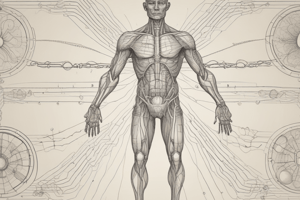Podcast
Questions and Answers
What is the primary purpose of homeostasis in living organisms?
What is the primary purpose of homeostasis in living organisms?
- To adapt to changing external environments
- To eliminate waste products efficiently
- To enhance energy production
- To maintain a stable internal environment (correct)
Which of the following systems is primarily responsible for transporting nutrients and waste products throughout the body?
Which of the following systems is primarily responsible for transporting nutrients and waste products throughout the body?
- Circulatory system (correct)
- Respiratory system
- Digestive system
- Musculoskeletal system
Which of the following best describes the role of feedback loops in homeostasis?
Which of the following best describes the role of feedback loops in homeostasis?
- They amplify deviations from the set point.
- They regulate only hormonal responses
- They sense deviations and trigger compensatory responses. (correct)
- They are not involved in bodily functions
In what way can manual therapy benefit an individual’s overall health?
In what way can manual therapy benefit an individual’s overall health?
Which system coordinates body responses to internal and external stimuli?
Which system coordinates body responses to internal and external stimuli?
What is one of the primary goals of techniques used in manual therapy?
What is one of the primary goals of techniques used in manual therapy?
Which of the following is NOT a component of the human body's systems that contribute to homeostasis?
Which of the following is NOT a component of the human body's systems that contribute to homeostasis?
What aspect of health can manual therapy potentially improve aside from physical function?
What aspect of health can manual therapy potentially improve aside from physical function?
Flashcards
What is Physiology?
What is Physiology?
The study of how living things function, from the smallest cells to the largest organ systems.
What is Homeostasis?
What is Homeostasis?
Maintaining a stable internal environment, despite changes outside the body.
What are the key roles of the Circulatory and Respiratory systems?
What are the key roles of the Circulatory and Respiratory systems?
The circulatory system carries oxygen and nutrients throughout the body, while the respiratory system takes in oxygen and gets rid of carbon dioxide.
What are the main roles of the Digestive, Nervous, and Musculoskeletal systems?
What are the main roles of the Digestive, Nervous, and Musculoskeletal systems?
Signup and view all the flashcards
What is the role of the Endocrine system?
What is the role of the Endocrine system?
Signup and view all the flashcards
What is Manual Therapy?
What is Manual Therapy?
Signup and view all the flashcards
What are the benefits of Manual Therapy?
What are the benefits of Manual Therapy?
Signup and view all the flashcards
How is Manual Therapy used?
How is Manual Therapy used?
Signup and view all the flashcards
Study Notes
Physiology
- Physiology is the study of the functions of living organisms and their parts.
- It encompasses a diverse range of processes, from the movement of molecules across cell membranes to the coordinated actions of entire organ systems.
- Physiological processes are often governed by complex feedback loops that maintain a stable internal environment, a state known as homeostasis.
Homeostasis
- Homeostasis is the maintenance of a relatively stable internal environment despite fluctuations in the external environment.
- This stability is essential for optimal function of cells, tissues, and organs.
- Homeostatic mechanisms involve feedback loops that sense deviations from the set point and initiate compensatory responses to restore equilibrium.
- Examples of regulated variables include body temperature, blood glucose levels, and blood pressure.
- Essential for survival and health.
Systems of the Body
- Human bodies are composed of several interconnected systems that work together to maintain homeostasis and carry out essential functions.
- Key systems include the circulatory, respiratory, digestive, nervous, musculoskeletal, and endocrine systems.
- Circulatory system transports oxygen, nutrients, and waste products throughout the body.
- Respiratory system facilitates gas exchange between the body and the environment.
- Digestive system processes food for absorption of nutrients.
- Nervous system coordinates body responses to internal and external stimuli.
- Musculoskeletal system provides support, movement, and protection.
- Endocrine system controls many bodily functions through hormones.
Benefits of Manual Therapy
- Manual therapy encompasses a variety of hands-on techniques used to diagnose and treat musculoskeletal conditions.
- Techniques include massage, mobilization, and manipulation of soft tissues and joints to improve physical function, reduce pain, and restore movement and mobility.
- Manual therapy aims at restoring the normal biomechanical function of tissues and improving range of motion.
- Can help to alleviate pain and discomfort, improve posture and balance, and increase flexibility and strength.
- Benefits can extend to improved overall body health, improved quality of life, and reducing reliance on medications.
- Techniques are often used in conjunction with other therapies such as exercise, education and lifestyle modifications.
- Evidence shows manual therapy can be a safe and effective approach for many conditions.
- Specific benefits vary based on the condition treated and the individual patient.
Studying That Suits You
Use AI to generate personalized quizzes and flashcards to suit your learning preferences.
Description
Explore the fascinating field of physiology, focusing on the functions of living organisms and their intricate processes. This quiz delves into the concept of homeostasis, the mechanisms that maintain a stable internal environment, and the interconnected systems of the human body essential for survival. Test your understanding and knowledge of these critical physiological concepts.




